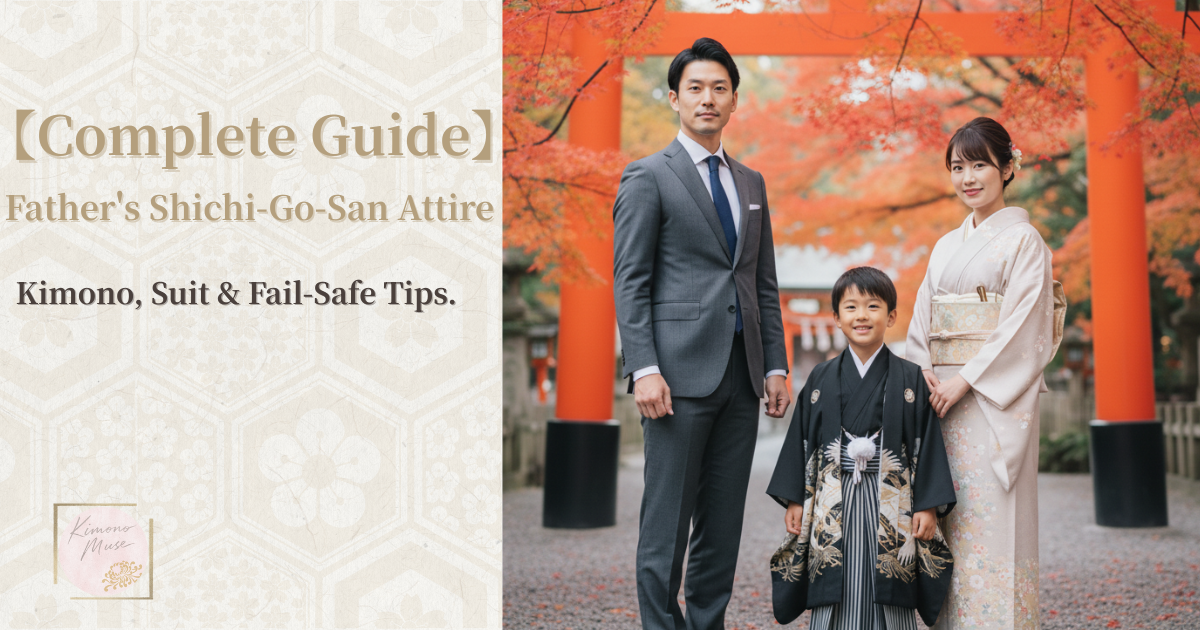Shichi-Go-San is a cherished milestone to celebrate your child’s healthy growth.
While the spotlight is, of course, on your child, the father’s attire and demeanor also play a surprisingly important role in shaping the overall impression of the family and the outcome of commemorative photos.
“What kind of suit should I wear?”
“Would it be acceptable if I try traditional Japanese attire?”
Many fathers may find themselves asking these questions with a bit of uncertainty.
In this guide, we’ll walk you through essential etiquette for fathers, how to choose the right suit or kimono, and even some tips on how to carry yourself on the day of the ceremony.
To help your child shine even brighter in their special attire, read on until the end.
- Basic Style: How to Choose the Right Suit and Follow Modern Etiquette
- How to Choose Traditional Attire: Guidelines for Enjoying Kimono as a Family
- Cleanliness Checklist: Final Touches for a Celebration-Ready Look
- Mindset for Shichi-Go-San: What Fathers Should Keep in Mind as Behind-the-Scenes Support
- Conclusion
Basic Style: How to Choose the Right Suit and Follow Modern Etiquette
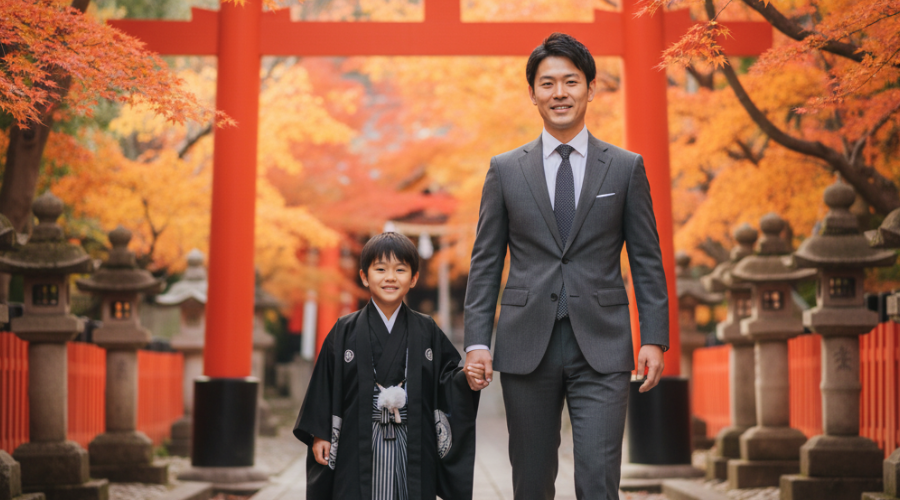
The most classic and reliable choice for a father’s outfit at Shichi-Go-San is a suit.
By prioritizing calm elegance and cleanliness over flashiness, you can never go wrong—no matter the setting.
Choosing the Color
Recommended options are dark tones such as navy, charcoal gray, or black.
These colors convey formality and create a refined impression both at the shrine and in photographs.
Choosing the Pattern
A solid color suit is the safest choice.
If you wish to add a pattern, a subtle narrow stripe is acceptable.
However, avoid fabrics with strong sheen or bold designs, as they can look inappropriate.
Shirt and Tie
A crisp white shirt is the standard for cleanliness and formality.
For the tie, choose subdued colors or modest patterns for an elegant look.
Silver or navy ties are especially well-suited for Shichi-Go-San.
Adding Accessories
A pocket square can add a subtle touch of festivity.
Opting for understated white or silver tones will enhance the celebratory mood without appearing too flashy.
NG Points: Suit Choices to Avoid
Fabrics with Strong Shine or Colors That Are Too Bright (such as White or Beige)
These can make you stand out more than your child, who is the main focus, so it’s best to avoid them.
Designs That Look Too Business-Like
Overly bold stripes or flashy check patterns are not suitable for a celebratory occasion like Shichi-Go-San.
Three Recommended Suit Styles for Fathers
For Shichi-Go-San, the father’s attire should generally be formal to semi-formal.
If the child is dressed in Western-style clothing and the mother’s outfit is also on the casual side, it’s perfectly acceptable for the father to wear a more relaxed style, such as a jacket-and-trousers combination.
However, be careful not to go too casual—jeans, sweatshirts, and similar items should be avoided.
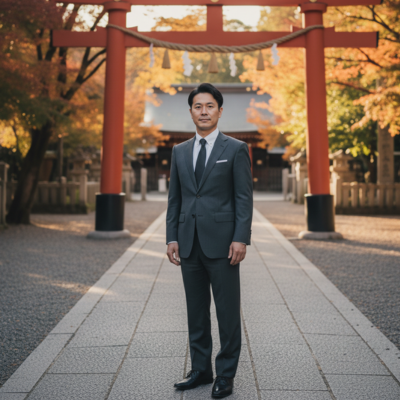
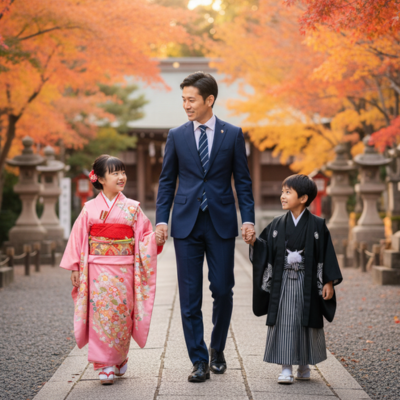
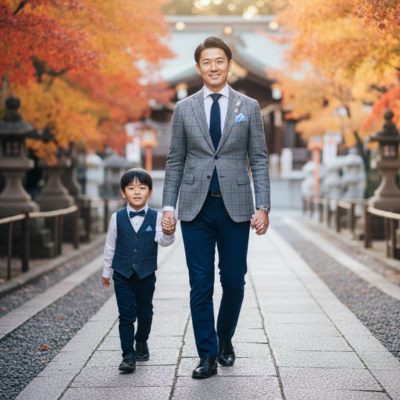
How to Choose Traditional Attire: Guidelines for Enjoying Kimono as a Family
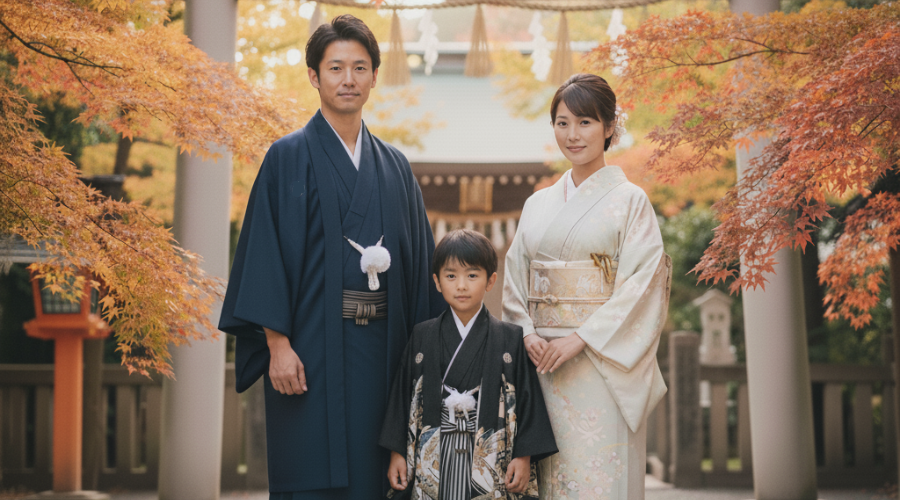
If your child or spouse wears kimono, the father choosing traditional attire as well will create a sense of harmony for the whole family, making the photos look even more elegant and festive.
However, it’s important to keep a few key etiquette points in mind.
● Example of Coordinating Kimono Formality Between Mother and Father
When both parents wear kimono for Shichi-Go-San, it is important to balance the level of formality.
Here is one example of how the mother’s and father’s attire can be coordinated.
| Mother’s Kimono | Father’s Kimono |
|---|---|
| Irotomesode (colored formal kimono with family crests) | Montsuki with haori and hakama (formal black kimono with crests, haori jacket, and pleated trousers) |
| Iromuji (plain colored kimono) | Montsuki with haori and hakama |
| Hōmongi (visiting kimono) | Montsuki with haori and hakama |
| Hōmongi (visiting kimono) | Montsuki kimono with haori, or haori and hakama |
| Tsukesage (semi-formal kimono with modest patterns) | Montsuki kimono with haori, or haori with less formal kimono (such as Edo-komon) |
The Basic Rule: Keep the Formality Lower Than the Child’s
At Shichi-Go-San, the main role is always the child. If the father wears a highly formal black montsuki, he may outshine the child in some cases.
Therefore, it’s safer to choose a calm, subdued style such as a montsuki haori and hakama without family crests.
Always Wear a Haori Jacket
When wearing traditional attire, adding a haori helps establish a proper sense of formality.
It also creates a neat overall impression and matches well with the solemn atmosphere of a shrine.
Note: Wearing kimono without a haori (known as kiritsure or “casual style”) is considered too informal for a formal event like Shichi-Go-San.
Footwear (Tabi Socks and Zōri Sandals)
White tabi socks are the safest choice and enhance the formal appearance.
Also, when wearing zōri sandals or setta, make sure in advance that they are clean and free from stains.
Tips on Choosing Colors
Navy, dark gray, or deep green—calm and subdued colors—are the most suitable choices.
Avoid flashy tones or colors that are too bright, as they may draw attention away from your child’s attire.
For Fathers New to Kimono
If you don’t usually wear kimono, the easiest and most recommended option is to use a kimono rental service.
These services can suggest colors and patterns that coordinate with your child’s attire, allowing you to achieve a harmonious family look with ease.
[Important!] NG Manners to Avoid When Wearing Kimono
Wearing Kimono Without a Haori (“Kiritsure”)
Wearing kimono without a haori, known as kiritsure, is considered too casual for a formal event like Shichi-Go-San and should be avoided.
Black Montsuki for the Highest Formality
As mentioned earlier, this level of formality may outshine your child. Avoid highly formal black montsuki with crests, and instead choose a more subdued haori and hakama without crests.
Color of Tabi Socks
White tabi socks are the safest option. Patterned or colored tabi tend to look casual and should be avoided.
Three Recommended Kimono Styles for Fathers
For many fathers, wearing kimono at Shichi-Go-San might be the first time since their own coming-of-age ceremony.
Whether you choose to purchase or rent, it’s best to start preparing early to ensure peace of mind.
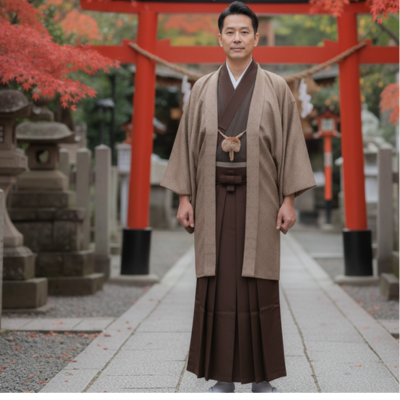
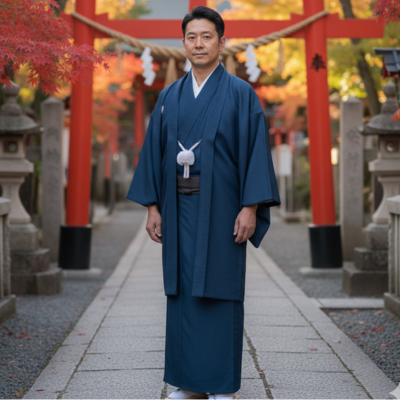
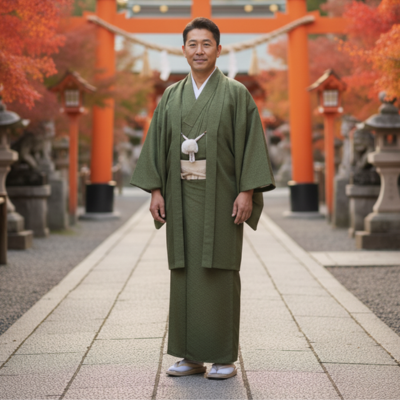
💡 Preparation Tips
If ordering custom-made from a kimono shop, it may take about three months to complete.
For rentals, popular kimono are often unavailable if you wait until the last minute.
Dressing in men’s kimono is not as complicated as for women, so trying it on your own is also fine.
Asking relatives, a beauty salon, or a professional dresser will make the process go smoothly.
Cleanliness Checklist: Final Touches for a Celebration-Ready Look
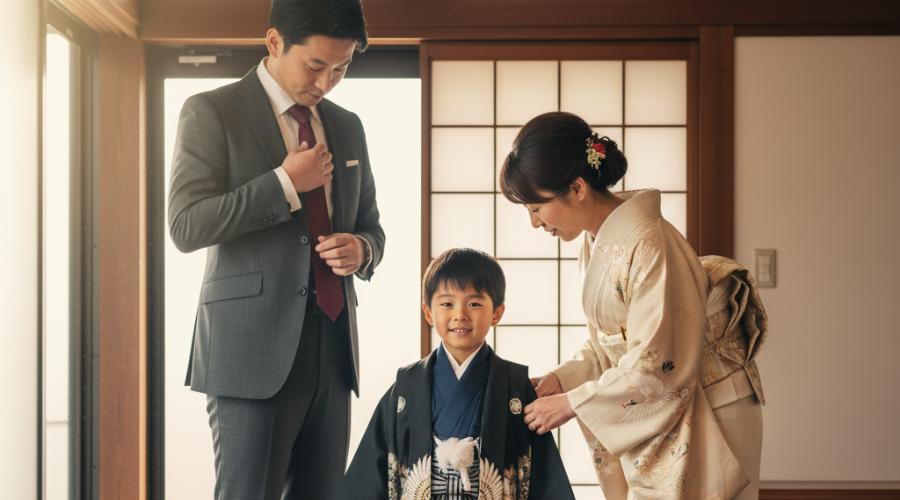
No matter how elegant your suit or kimono may be, lacking a sense of cleanliness can drastically affect your overall impression.
Shichi-Go-San is a special day to give thanks before the deities for your child’s growth. Approach it with grooming that is truly fitting for such a celebratory occasion.
1. Final Check of Suit and Shirt
The details of your attire can greatly influence the impression in family photos.
Make sure to confirm even the smallest points.
- Wrinkle Check: Carefully check that there are no noticeable wrinkles on your suit or shirt, especially around the collar, cuffs, and behind the knees. Ironing these areas beforehand gives peace of mind.
- Stain Check: Look over your tie, shirt collar, cuffs, and pockets for any stains or dirt.
- Fit: An ill-fitting suit can appear sloppy. Check in the mirror beforehand to ensure the shoulders and sleeve length are correct.
2. Footwear Reflects Your Grooming
Your shoes are more noticeable than you might expect. Dirty shoes can ruin the formality of your entire outfit.
- Polish Your Shoes: Make sure leather shoes are well-polished. Avoid pairs with visible scuffs or damage, and choose ones appropriate for a formal occasion.
- Socks: Wear plain black or dark navy socks that match your suit. Ensure they are long enough so your legs won’t show when seated.
- Tabi Socks with Kimono: If wearing kimono, use pure white tabi socks. Double-check in advance that they are spotless.
3. Detailed Grooming
Extra attention is needed for the face and hands, as they are especially noticeable in photos.
- Nails & Facial Hair: Keep nails short and clean, and either shave or neatly trim facial hair to maintain a fresh appearance.
- Hairstyle: Fix any bedhead and use hair products if necessary to achieve a tidy, clean look.
- Accessories: Make a final check to ensure items like belts, ties, and tie pins are not overly flashy and match the overall tone of your suit.
Final Confirmation Checklist
| Item | What to Check | Key Points |
|---|---|---|
| Suit & Shirt | Wrinkles, creases, stains, fit | Pay close attention to collar, cuffs, and behind the knees |
| Shoes & Socks | Polish leather shoes; socks should be black or dark navy | Ensure socks are long enough so legs don’t show when seated |
| Tabi (for Kimono) | Pure white, spotless | Best to check the day before |
| Nails & Facial Hair | Nails short and clean; beard neatly shaved or trimmed | Especially noticeable in photos |
| Hairstyle | Fix bedhead, maintain a tidy and fresh style | Use styling products for a natural finish |
| Accessories | Belt, tie, tie pin | Match with the overall tone of the suit |
Additional Notes
No matter how expensive your suit or kimono may be, a lack of cleanliness will greatly diminish the overall impression.
Shichi-Go-San is an event that will be remembered in photos, so wrinkles, dirty shoes, or messy hair can easily stand out.
For peace of mind, make sure to take care of these details the day before.
Mindset for Shichi-Go-San: What Fathers Should Keep in Mind as Behind-the-Scenes Support
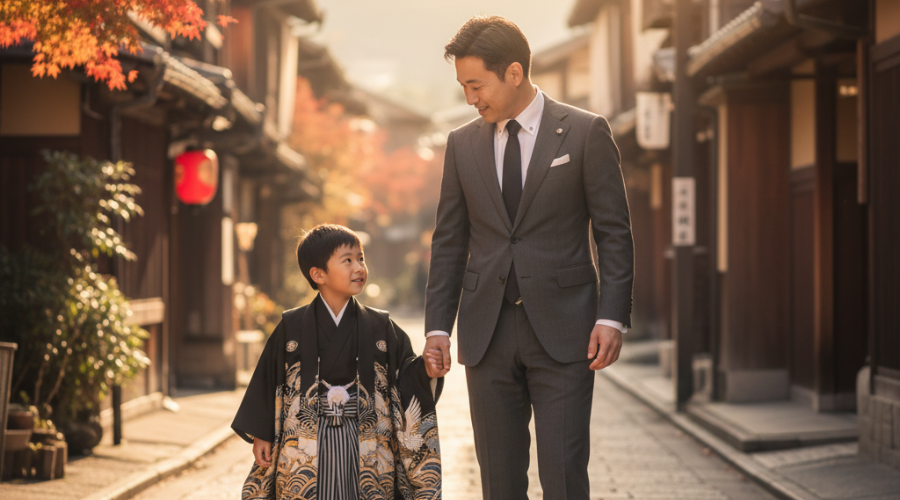
The true star of Shichi-Go-San is, of course, your child.
As the father, your role on the day is to support the family without stepping too far into the spotlight—think of yourself as the “supporting cast” who helps everyone shine.
With your attire properly prepared, keeping the following mindset in mind will help you feel confident throughout the day.
● Take Leadership for the Whole Family
When those helping with dressing and preparation (often those wearing kimono) are busy, it is an important role for the father to carry belongings and assist with moving around.
He should also take the lead in planning the schedule and suggesting breaks, helping the whole family stay calm and comfortable with small acts of consideration.
● Pay Attention to Posture and Expression During Photos
In group photos, it’s easy for posture to collapse or for expressions to become stiff.
Simply keeping your back straight and maintaining a gentle expression can dramatically improve the outcome of family photographs.
● Be a Source of Reassurance for Your Child
In unfamiliar clothes and settings, children may feel nervous or become fussy.
In such moments, the father’s calm presence provides comfort. Even holding their hand or offering a few kind words can be enough.
● Don’t Forget to Enjoy the Day
While it’s important to keep the schedule on track, remember that enjoying the celebration with your family is just as valuable.
The memories of smiling and sharing the moment will remain an even greater treasure than the photographs themselves.
Conclusion
Shichi-Go-San is a precious celebration of your child’s healthy growth.
A father’s attire plays an important role in highlighting the child, who is the true star, while also bringing harmony to the family’s overall appearance.
Whether in a suit or kimono, the key is cleanliness and subtle elegance.
By choosing an outfit that is calm and not overly flashy, your appearance in photos will naturally leave a positive impression.
On the day itself, supporting the family behind the scenes—such as carrying belongings or assisting with movement—will bring reassurance to everyone.
When the father takes the lead, the entire family can feel at ease and truly enjoy the celebration of Shichi-Go-San together.
Above all, don’t get too caught up in attire or logistics. What matters most is cherishing the day with your family.
The moments you spend together with smiles will remain an irreplaceable treasure in your hearts, far beyond the photographs.
Related Articles
✿ Column: Fumi’s Kimono Diary ✿
A few years ago, during a Shichi-Go-San photo session, once all the pictures of my child had been taken, the photographer said, “Now, let’s finish with you holding hands with your father.”
My son, who had been nervous in his unfamiliar haori and hakama, suddenly relaxed the moment he gripped his father’s hand tightly.
That smile he showed then still comes vividly back to me every time I look at the photo.
At Shichi-Go-San, our attention often goes to the outfits and the preparations. Yet for a child, the true source of strength is the reassuring presence of a parent right by their side.
A father’s role is not to do anything extraordinary, but simply to remain calm and be there. And that alone is more than enough.
